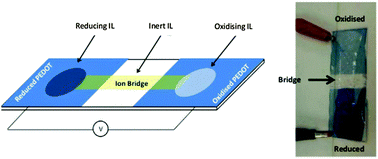Organic energy devices from ionic liquids and conducting polymers†
Abstract
The use of smart technologies in our daily lives, from smartphones to auto-dimming windows to touch sensors, has become pervasive. With growing desire for these devices to be conformable and flexible, traditional materials are being replaced to create a class of products known as active organic electronic devices (OEDs). These new devices owe their ability to switch electrical and/or optical function to the intimate interaction between an inherently conducting polymer and electrolyte, typically an ionic liquid. Herein, we provide the first observations that specific ionic liquids can reduce or oxidise conducting polymers upon intimate contact in the absence of any electrical stimuli. The ability to reduce or oxidise the inherently conducting polymer depends on the cation and anion pair within the ionic liquid. Extending the utility of this phenomenon is made by fabricating OEDs such as prototype fuel cells, supercapacitors and smart windows.


 Please wait while we load your content...
Please wait while we load your content...